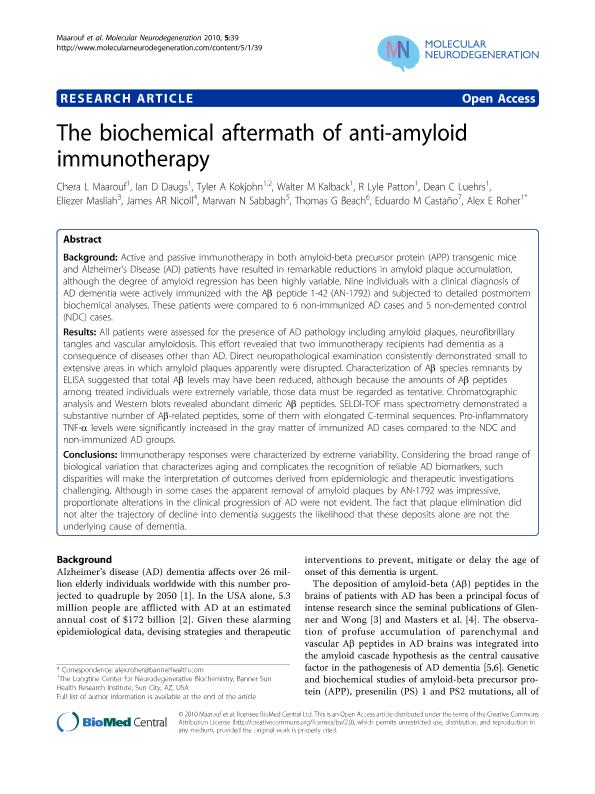Mostrar el registro sencillo del ítem
dc.contributor.author
Maarouf, Chera L.
dc.contributor.author
Daugs, Ian D.
dc.contributor.author
Kokjohn, Tyler A.
dc.contributor.author
Kalback, Walter M.
dc.contributor.author
Patton, R. Lyle
dc.contributor.author
Luehrs, Dean C.
dc.contributor.author
Masliah, Eliezer
dc.contributor.author
Nicoll, James A. R.
dc.contributor.author
Sabbagh, Marwan N.
dc.contributor.author
Beach, Thomas G.
dc.contributor.author
Castaño, Eduardo Miguel

dc.contributor.author
Roher, Alex E.
dc.date.available
2017-02-09T15:46:19Z
dc.date.issued
2010-10
dc.identifier.citation
Maarouf, Chera L.; Daugs, Ian D.; Kokjohn, Tyler A.; Kalback, Walter M.; Patton, R. Lyle; et al.; The biochemical aftermath of anti-amyloid immunotherapy; Biomed Central; Molecular Neurodegeneration; 5; 10-2010; 39-45
dc.identifier.issn
1750-1326
dc.identifier.uri
http://hdl.handle.net/11336/12793
dc.description.abstract
BACKGROUND: Active and passive immunotherapy in both amyloid-beta precursor protein (APP) transgenic mice and Alzheimer's Disease (AD) patients have resulted in remarkable reductions in amyloid plaque accumulation, although the degree of amyloid regression has been highly variable. Nine individuals with a clinical diagnosis of AD dementia were actively immunized with the Aβ peptide 1-42 (AN-1792) and subjected to detailed postmortem biochemical analyses. These patients were compared to 6 non-immunized AD cases and 5 non-demented control (NDC) cases. RESULTS: All patients were assessed for the presence of AD pathology including amyloid plaques, neurofibrillary tangles and vascular amyloidosis. This effort revealed that two immunotherapy recipients had dementia as a consequence of diseases other than AD. Direct neuropathological examination consistently demonstrated small to extensive areas in which amyloid plaques apparently were disrupted. Characterization of Aβ species remnants by ELISA suggested that total Aβ levels may have been reduced, although because the amounts of Aβ peptides among treated individuals were extremely variable, those data must be regarded as tentative. Chromatographic analysis and Western blots revealed abundant dimeric Aβ peptides. SELDI-TOF mass spectrometry demonstrated a substantive number of Aβ-related peptides, some of them with elongated C-terminal sequences. Pro-inflammatory TNF-α levels were significantly increased in the gray matter of immunized AD cases compared to the NDC and non-immunized AD groups. CONCLUSIONS: Immunotherapy responses were characterized by extreme variability. Considering the broad range of biological variation that characterizes aging and complicates the recognition of reliable AD biomarkers, such disparities will make the interpretation of outcomes derived from epidemiologic and therapeutic investigations challenging. Although in some cases the apparent removal of amyloid plaques by AN-1792 was impressive, proportionate alterations in the clinical progression of AD were not evident. The fact that plaque elimination did not alter the trajectory of decline into dementia suggests the likelihood that these deposits alone are not the underlying cause of dementia.
dc.format
application/pdf
dc.language.iso
eng
dc.publisher
Biomed Central

dc.rights
info:eu-repo/semantics/openAccess
dc.rights.uri
https://creativecommons.org/licenses/by-nc-sa/2.5/ar/
dc.subject
Alzheimer
dc.subject
Immunotherapy
dc.subject
Pathology
dc.subject.classification
Neurociencias

dc.subject.classification
Medicina Básica

dc.subject.classification
CIENCIAS MÉDICAS Y DE LA SALUD

dc.title
The biochemical aftermath of anti-amyloid immunotherapy
dc.type
info:eu-repo/semantics/article
dc.type
info:ar-repo/semantics/artículo
dc.type
info:eu-repo/semantics/publishedVersion
dc.date.updated
2017-02-07T13:52:57Z
dc.journal.volume
5
dc.journal.pagination
39-45
dc.journal.pais
Reino Unido

dc.description.fil
Fil: Maarouf, Chera L.. Banner Sun Health Research Institute. The Longtine Center for Neurodegenerative Biochemistry; Estados Unidos
dc.description.fil
Fil: Daugs, Ian D.. Banner Sun Health Research Institute. The Longtine Center for Neurodegenerative Biochemistry; Estados Unidos
dc.description.fil
Fil: Kokjohn, Tyler A.. Banner Sun Health Research Institute. The Longtine Center for Neurodegenerative Biochemistry; Estados Unidos
dc.description.fil
Fil: Kalback, Walter M.. Banner Sun Health Research Institute. The Longtine Center for Neurodegenerative Biochemistry; Estados Unidos
dc.description.fil
Fil: Patton, R. Lyle. Banner Sun Health Research Institute. The Longtine Center for Neurodegenerative Biochemistry; Estados Unidos
dc.description.fil
Fil: Luehrs, Dean C.. Banner Sun Health Research Institute. The Longtine Center for Neurodegenerative Biochemistry; Estados Unidos
dc.description.fil
Fil: Masliah, Eliezer. University of California. Department of Neurosciences; Estados Unidos
dc.description.fil
Fil: Nicoll, James A. R.. University of Southampton School of Medicine. División of Clinical Neurosciences; Reino Unido
dc.description.fil
Fil: Sabbagh, Marwan N.. Banner Sun Health Research Institute. Cleo Roberts Center for Clinical Research; Estados Unidos
dc.description.fil
Fil: Beach, Thomas G.. Banner Sun Health Research Institute. Department of Neuropathology; Estados Unidos
dc.description.fil
Fil: Castaño, Eduardo Miguel. Consejo Nacional de Investigaciones Científicas y Técnicas. Oficina de Coordinación Administrativa Parque Centenario. Instituto de Investigaciones Bioquimicas de Buenos Aires; Argentina. Fundación Instituto Leloir; Argentina
dc.description.fil
Fil: Roher, Alex E.. Banner Sun Health Research Institute. The Longtine Center for Neurodegenerative Biochemistry; Estados Unidos
dc.journal.title
Molecular Neurodegeneration

dc.relation.alternativeid
info:eu-repo/semantics/altIdentifier/url/https://molecularneurodegeneration.biomedcentral.com/articles/10.1186/1750-1326-5-39
dc.relation.alternativeid
info:eu-repo/semantics/altIdentifier/doi/http://dx.doi.org/10.1186/1750-1326-5-39
Archivos asociados
